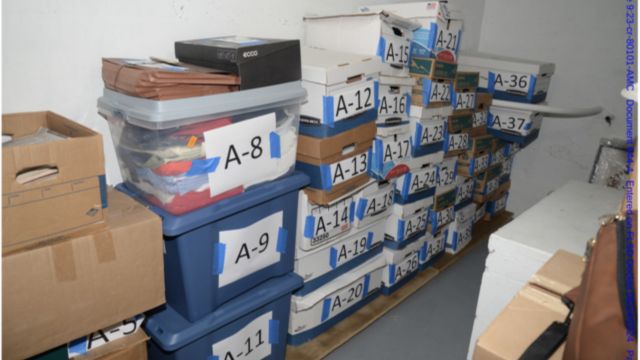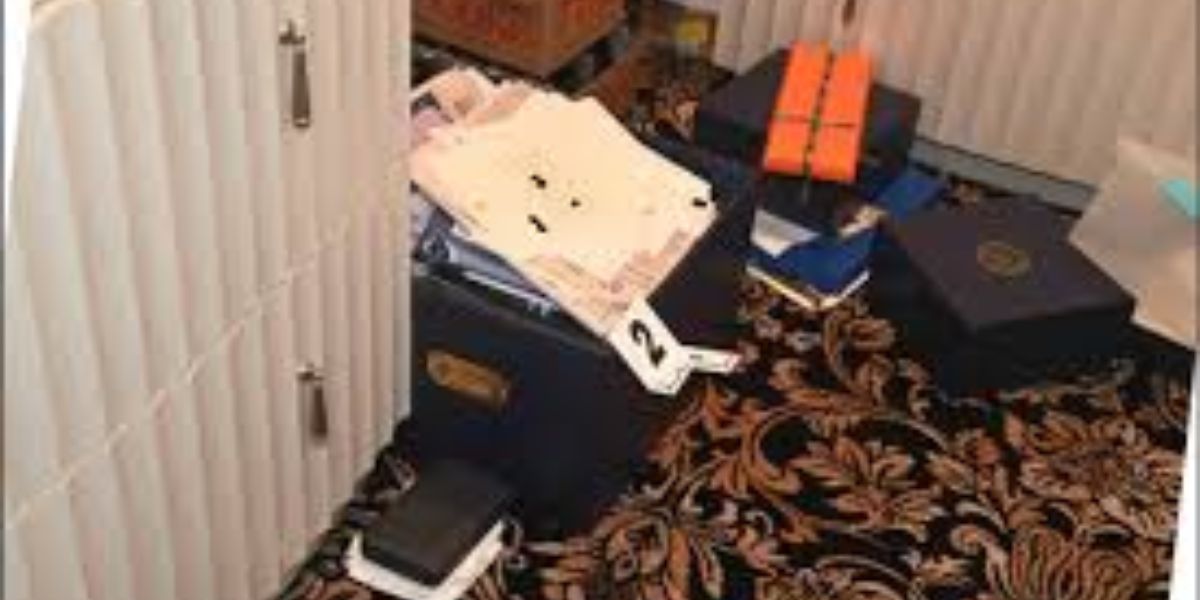Washington, USA —
Unreleased images from the FBI’s August 2022 search of former President Donald Trump’s South Florida resort provide more insight into how the former leader maintained mementos from his administration with classified information.
In the continuing federal lawsuit against Trump in South Florida, special counsel Jack Smith filed a court filing on Monday that included the images, some of which had not been made public.
The former president is charged by prosecutors with hindering the Justice Department’s investigation and mishandling documents that contained the nation’s secrets after leaving the White House in January 2021.

With a not guilty plea, Trump has been accused of 40 charges, including the illegal retention of material related to national defense. A request for comment regarding Smith’s most recent file was not immediately answered by his presidential campaign.
SEE MORE –
Big Connection! DNC Targets Trump’s Relationship with Black Community in Philadelphia Campaign
Smith’s office filed the document in response to Trump’s attempt to have the indictment dropped and have all evidence taken from Mar-a-Lago that was legally searched suppressed. In August 2022, the FBI retrieved over 100 documents with secret markings; 21 of these records support Trump’s charges of deliberate withholding of national defense material.
Over 300 classified government documents were gathered by federal investigators in the course of their probe into the former president.
Trump has claimed that the FBI agents who carried out the search request did not preserve the original order of the documents and did not take pictures illustrating the records’ sequential arrangement within each box.
In a document dated May 3, the special counsel admitted that the contents of several boxes did not match the arrangement when the FBI searched them.
Prosecutors, however, argued that the changes had no bearing on the charges against Trump and his two codefendants and that it made no difference “where precisely within a box a classified document was stored at Mar-a-Lago” regarding the defendants’ capacity to properly review the evidence.
The failure to sustain the injunction and preserve the materials, according to Trump’s legal team, violated his right to due process.
Because it would undermine their argument that Trump knew secret materials were kept in the boxes with other personal belongings and purposefully kept them after becoming president, they accused the prosecutors of hiding information regarding the order of the records.
SEE MORE –
Trump’s Gun License at Risk of Revocation After Hush Money Trial Conviction
But despite a disruption in the exact sequence of papers taken from Mar-a-Lago, Smith’s team contended in his most recent filing that there is no reason to dismiss the allegations against Trump.
“Trump personally chose to keep documents containing some of the nation’s most highly guarded secrets in cardboard boxes along with a collection of other personally chosen keepsakes of various sizes and shapes from his presidency,” the special counsel’s team of prosecutors stated.
The former president was charged with keeping the boxes holding classified material in a “haphazard manner,” and the FBI agents who carried out the search “did so professionally, thoroughly, and carefully under challenging circumstances,” according to their statements. Smith is suing separately to prevent Trump from speaking in public in a way that could jeopardize the safety of the law enforcement personnel working on the case.
At the Monday hearing, U.S. District Judge Aileen Cannon, who is overseeing the case, appeared unresponsive to the prosecution’s attempts to change the terms of his release.
View the images that were included in Smith’s file and captured by the FBI during their search of Mar-a-Lago:
Photographs taken in late December 2021 by Trump adviser Walt Nauta depict boxes in a Mar-a-Lago storage room that had toppled over, spilling their contents onto the ground. In the papers case, Nauta was also charged by Smith; she entered a not guilty plea.
The FBI found a classified record in one of those fallen boxes, designated as A-35 in court documents, according to the prosecution. The record was found during the search conducted in August 2022. Stacks of boxes, including A-35, are visible in the Mar-a-Lago storage room in an FBI search photo. This photograph was taken around eight months after Nauta texted her with the pictures of the falling boxes.
The classified record in box A-35, according to Smith’s filing, is the basis for Count 8 of the indictment. The document is dated October 4, 2019, and it pertains to the “military capabilities of a foreign country.” According to the accusation, the record bears a classification marking of “SECRET//REL TO USA, FVEY”. Australia, Canada, New Zealand, the United States, and the United Kingdom make up the Five Eyes intelligence alliance, or FVEY.
As part of the Mar-a-Lago search, Smith’s team reported, agents and members of the so-called Evidence Response Team went through the boxes in the storage room to hunt for any papers with seizure-prohibited classified marks. If such a record was found, the team member removed it, separated it, recorded the box where it was located and replaced the sensitive document with a placeholder sheet, prosecutors explained in their filing.
That placeholder sheet was a preprinted classified cover sheet, but after agents ran out of those cover sheets, they used blank pieces of paper with “handwritten annotations to identify the document,” according to Smith’s filing.
As part of the process, the Evidence Response Team took photos of the documents, with the cover sheets added by FBI agents, next to the box they were found in, prosecutors wrote.
In addition to searching the storage room, the FBI also went through the “45 Office,” which consisted of an anteroom where staff had desks, the former president’s office, a closet attached to Trump’s office, and two bathrooms.
According to the special counsel’s filing, agents with a filter team searched the closet first for anything that might be considered privileged. They discovered a “blue, covered, leatherbound box full of various papers, including numerous newspapers, newspaper clippings, magazines, note cards of various sizes, presidential correspondence, empty folders, and loose cover sheets for classified information, as well as documents marked classified.”
The filter team member then alerted the case team, whose agents were investigating the case, that documents marked classified had been discovered in the box, and two agents went through it, the filing states. They found “numerous” documents with classified markings, some of which had classification cover sheets attached, as well as loose cover sheets, the special counsel’s team said.
The FBI took photos of the blue box with its cover off , prosecutors wrote.
Smith and his team argued in his filing that the contents of the boxes belonged to Trump and no one else, and said agents going through them during the Mar-a-Lago search found keepsakes “valuable only to Trump.”
Prosecutors wrote that the boxes “had no apparent organization whatsoever” and contained an array of items: clothing, picture frames, magazines, shoes, newspapers, newspaper clippings, greeting cards, binders, Christmas ornaments and correspondence. Photos taken by the FBI show the boxes and some of their contents to “provide a sense of the variety of items” in them, with classified cover sheets positioned alongside the boxes, according to Smith’s filing.
